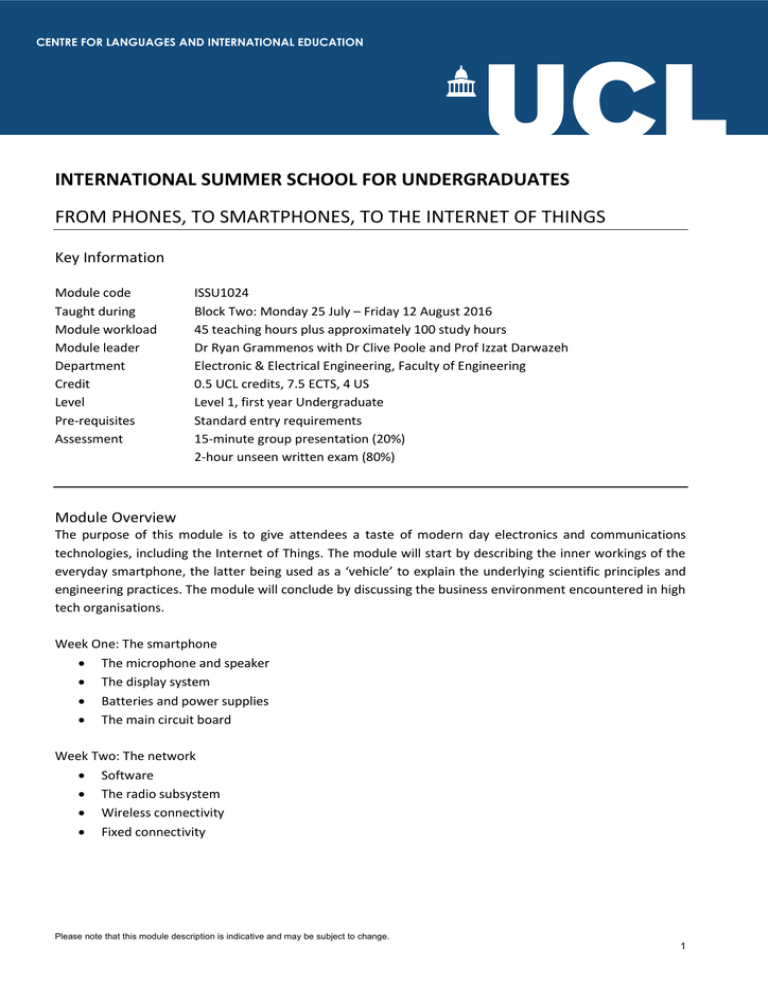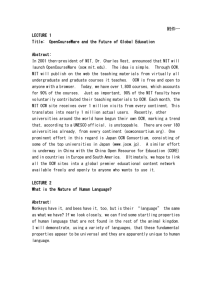INTERNATIONAL SUMMER SCHOOL FOR UNDERGRADUATES Key Information
advertisement

CENTRE FOR LANGUAGES AND INTERNATIONAL EDUCATION INTERNATIONAL SUMMER SCHOOL FOR UNDERGRADUATES FROM PHONES, TO SMARTPHONES, TO THE INTERNET OF THINGS Key Information Module code Taught during Module workload Module leader Department Credit Level Pre-requisites Assessment ISSU1024 Block Two: Monday 25 July – Friday 12 August 2016 45 teaching hours plus approximately 100 study hours Dr Ryan Grammenos with Dr Clive Poole and Prof Izzat Darwazeh Electronic & Electrical Engineering, Faculty of Engineering 0.5 UCL credits, 7.5 ECTS, 4 US Level 1, first year Undergraduate Standard entry requirements 15-minute group presentation (20%) 2-hour unseen written exam (80%) Module Overview The purpose of this module is to give attendees a taste of modern day electronics and communications technologies, including the Internet of Things. The module will start by describing the inner workings of the everyday smartphone, the latter being used as a ‘vehicle’ to explain the underlying scientific principles and engineering practices. The module will conclude by discussing the business environment encountered in high tech organisations. Week One: The smartphone The microphone and speaker The display system Batteries and power supplies The main circuit board Week Two: The network Software The radio subsystem Wireless connectivity Fixed connectivity Please note that this module description is indicative and may be subject to change. 1 Week Three: Internet and Business Protocols and services The Internet of Things The high tech business environment Module Aims The aims of the module are: To provide an informative treatment of the architecture of a smartphone including the technologies and techniques used to transmit signals between different locations. To introduce students to the concepts and physical principles required to develop these technologies and techniques. To deliver a basic understanding of key topics in electronic engineering, such as devices, circuits, systems and signal processing. To offer insights into the emerging theme of the Internet of Things. To give an introduction to the challenges encountered in the world of high tech business. Teaching Methods The course is delivered through formal lectures, tutorials and project work. Assessment is carried out through a written examination (80%) and the presentation of each group’s project work (20%). Student support will be provided via tutorials, electronic communication and face-to-face meetings if and when required Learning Outcomes Upon successful completion of this module, students will: Understand the fundamental principles of electronic engineering. Demonstrate knowledge of a modern day smartphone’s system architecture. Comprehend the technologies and techniques used to build smartphones and transmit signals. Realise that the underlying concepts of smartphones and communication networks may be extended and applied to other areas, such as the Internet of Things. Make an educated guess of what the future holds for smart devices and systems, as well as the disruptive business models that will emerge. Assessment Methods 15-minute group presentation (20%) 2-hour unseen written exam (80%) Key Texts PHYSICAL ITEMS (available in UCL's Libraries): 1) Hands-on electronics : a practical introduction to analog and digital circuits http://www.cambridge.org/gb/academic/subjects/engineering/circuits-and-systems/hands-electronicspractical-introduction-analog-and-digital-circuits 2) Foundations of Analog and Digital Electronic Circuits, 2005, Anant Agarwal http://store.elsevier.com/Foundations-of-Analog-and-Digital-Electronic-Circuits/Anant-Agarwal/isbn9781558607354/ Please note that this module description is indicative and may be subject to change. 2 3) From GSM to LTE-Advanced: An Introduction to Mobile Networks and Mobile Broadband http://eu.wiley.com/WileyCDA/WileyTitle/productCd-1118861957.html 4) 3G, 4G and Beyond: Bringing Networks, Devices and the Web Together, 2nd Edition http://eu.wiley.com/WileyCDA/WileyTitle/productCd-1118341481,subjectCd-EE26.html 5) Cellular Radio: Principles and Design http://www.amazon.co.uk/Cellular-Radio-Principles-R-C-V-Macario/dp/0333691539 ONLINE: MIT Open Courseware (MIT OCW): 6) Circuits and Electronics http://ocw.mit.edu/courses/electrical-engineering-and-computer-science/6-002-circuits-and-electronicsspring-2007/ 7) Introduction to Electronics, Signals, and Measurement http://ocw.mit.edu/courses/electrical-engineering-and-computer-science/6-071j-introduction-toelectronics-signals-and-measurement-spring-2006/ 8) Information Technology I http://ocw.mit.edu/courses/sloan-school-of-management/15-564-information-technology-i-spring2003/index.htm Access via UCL Online (SFX @ UCL): 9) Unit and Ubiquitous Internet of Things https://www.crcpress.com/Unit-and-Ubiquitous-Internet-of-Things/Ning/9781466561663 10) The Internet of Things: Connecting Objects http://eu.wiley.com/WileyCDA/WileyTitle/productCd-1848211406.html Other Online Links: 11) Cellular Telecommunications & Cell Phone Technology http://www.radio-electronics.com/info/cellulartelecomms/ Please note that this module description is indicative and may be subject to change. 3


